
Aimst University M.B.B.S Community Medicine and District Health Office Posting
MBBS Batch 7 District Health Office Posting in Kuala Muda, Kedah Darul Aman
Week 1 (27/07/2008-01/08/2008)
The Team Posted to Kuala Muda District Health Office
We are a team consist of 13 elegant medical students who will be undergoing our 4th year training in Kuala Muda DHO from 27 July 2008 - 8 August 2008 (The end of DHO is the starting of the 2008 Olympic!).
We are required to learn their training, job responsibility, methods of interacting with the community, planning and scheduling, record maintainance, reports generated and dispatched, response to feed back from higher authorities, and prepareness for contingencies and emergiencies including outbreaks in Kuala Muda DHO itself. The scope includes family health, disease control, food quality control, BAKAS (water quality and sanitaion), vector borne disease and KPAS.
Below are the team members:
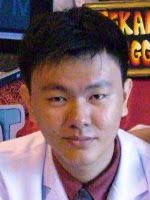
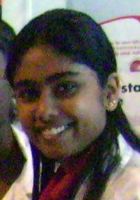
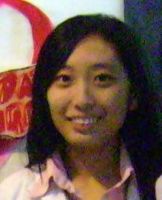
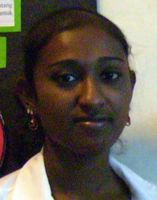
From left to right: Gan Chye Chung (Leader/Gan), Rathna Ramayaj (Rathna), Chai Huei Xian (Helly), K.Gaaitheri (Gaaitheri).
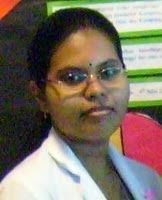
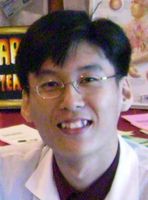
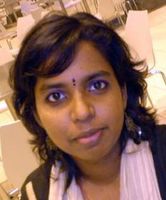
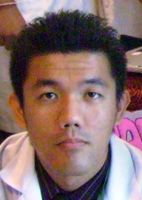
From left to right: Govind Parimalahr (Pari), Hong Chia Leong (Chia Leong), S. Kavitha (Kavitha), Leiw Yew Chai (Yew Chai).
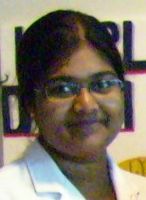
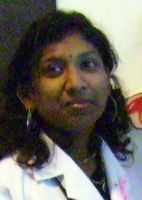
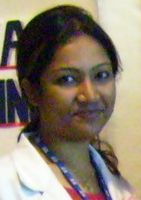

From left to right: M. Dineshi Dias (Dineshi), S. Mogana (Mogana), P. Praveena (Praveena), B. Sivasangkari (Sangkari).
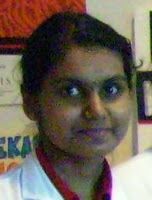
C. Thanalectchumy (Thana).
Hope that we could bring you lively and informative experiences in DHO posting!
27.7.08(DAY 1): STARTING EARLIER THAN IT IS THOUGHT AND FINISHED EARLIER THAN IT IS THOUGHT
KMDHO team here to greet you all with the morale of "it is good being earlier to work place"......
Thirteen of us reached around 7.45am rather than 8.30am as scheduled. We gathered at the lobby, a place which was so familiar to us (as we were here once this building was still functioning as SP General Hospital) by 8 am.
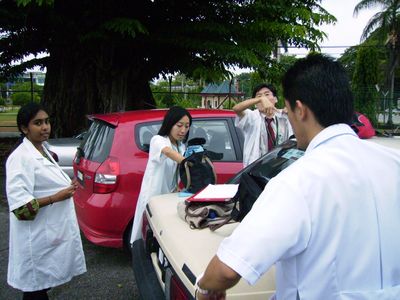
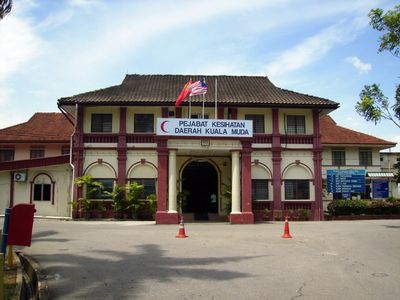
Left:Gearing up with our coats and apparatus.
Right: Doesn't this building looks familiar to you ?
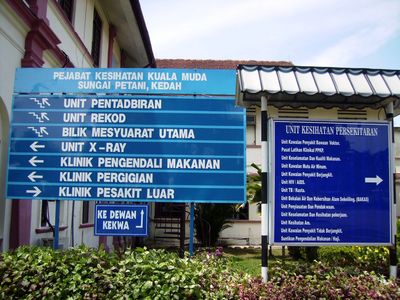
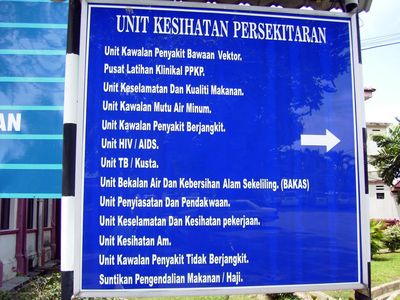
Boards directing the location of the Units.
Sharp at 8am while we were sitting at the waiting area in front of the X-ray department, suddenly a man around early thirties approached us with a sweet cheerful smile. He is Mr. Berhanudin (Berhan) a Health Promotion Officer a.k.a. Penolong Pegawai Promosi Kesihatan PP(PK) of Kuala Muda DHO (KMDHO). He invited us humbly to a meeting room and asked if we have taken our breakfast. He will be the coordinator for us throughout this 2 weeks DHO posting.
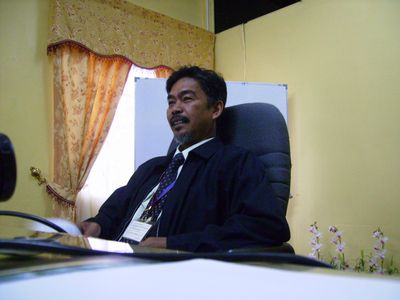
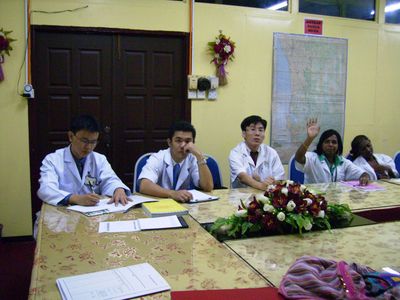
Left: Mr. Berhan PP(PK)
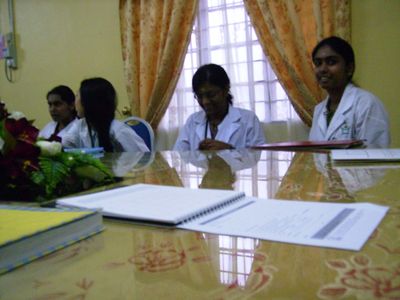
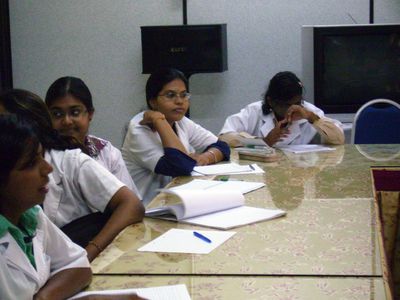
Everyone was so eager to start the day.
Then sharp at 9 am, the respected lady incharged of the DHO, Dr. Umai Kalsom, Medical Officer of Health (MOH) or in local designation, (PKD) of KM DHO gave us a talk on the background, objectives, vision & mission, organisation chart, unit services, and highlights of the District Health Office. She was very enthusiastic in explaining to us. Every bits of her efforts was not wasted as she gave us concise information on what is the exact role of preventive and promotive medicine carrried out by DHO.
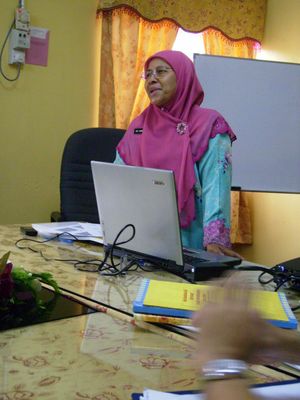
Dr. Umai Kalsom, Medical Officer of Health PKD of KM DHO
We will only highlight what is the organisation in DHO and the unit services available in this blog apart from the many more informative lectures because this will be the core knowledge for us in this DHO posting (of course we will highlight their job responsibilities in detail when we reached respetive department).
KMDHO consists of 4 core services:
DHO is lead by 2 persons in charged namely Medical Officer of Health a.k.a. Pegawai Kesihatan Daerah PKD (U52) and 2nd MOH PKD (U48). Under both of them is a Family Medicine Specialist (FMS) a.k.a. PPK (U48). FMS is the only special features available in Malaysia.
Under PKD and FMS, there are 4 main units:
- Family Health Development Unit (Curative Unit)
- Primary Health Care (Handle by PP U29, PKB R3, Attenden U1)
- Maternal & Child Health ( JK U29, JD/PJ U17, Bidan U11, Attendan U1)
- Lab (JTMP U29, PTMP U11)
- Pharmacy (PF U29)
- Nutrition (will update this fact soon)
- Environmental Health (Preventive Unit)
- Infectious Disease Control
- Infectious Disease Control (Vector Borne)
- General Health
- Food ∓ Quality
- BAKAS
- Occupational Safety & Environmental Health
- Water Quality Control
- Health Promotion (Promotive Unit)
This unit is lead by Health Promotion Officer PP(PK) U41. The team consists of several Health Promotion Unit JAV N17 - Administration
- Services
- Finance
- Admin
After Dr. Umai Kalsom's lecture, we had a short break and we were briefed on Primary Health Care in KMDHO by Dr. Othman Hj. Siru who is the 2nd Medical Officer of Health PKD U48. He is a very experienced doctor in which he shared with us his experience in his Preventive and Promotive Health care.
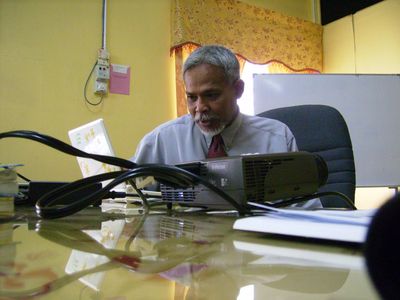
Dr. Othman Hj. Siru who is the 2nd Medical Officer of Health
After his lecture we went back at 12.30pm as our evening lectures are posponed to tommorow.
That's why i put the title as "STARTING EARLIER THAN IT IS THOUGHT AND FINISHED EARLIER THAN IT IS THOUGHT".
The morale of "it is good being earlier to work place" took place when Mr. Berhan suddenly approached us sharp at 8am. Imagine if he has to wait us for another 30 minutes (perhaps > 30 minutes with "MALAYSIAN TIMING") and I am sure he will have bad impression on us. Anyhow, there is no harm in going to work earlier but being late will bring death (in the context of our job responsiblity).
Guys and girls, what i wanted to keen on is "second does matter!"
That's all for today folks. We continue our journey to KMDHO tomorrow. Have a good day!
28.7.08(DAY 2): Started with lectures like those in class again but ended with interesting field work
KMDHO TEAM LOADED WITH FACTS AGAIN AND AGAIN BUT ENDS THE DAY WITH THEIR 1ST FIELD WORK!
KMDHO team gathered in meeting room by 8.30am. We were loaded once again with facts on the organisation chart and the function of each units but this time more specifically on the job functions of Environmental Health. The lecture was given by the Chief Ass. Environmental Health Officer (K) PPKP Tn Hj. Samad. Though it was lengthy but we felt that the core messages he conveyed were indeed important and useful. The only difference of the information given is that each topic is explained with his experience in handling the local environmental health problems.
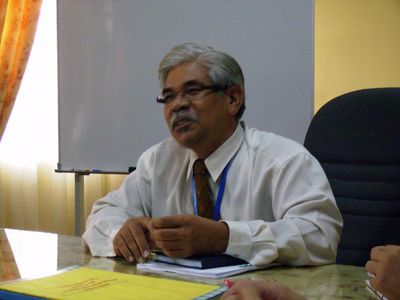
Chief Ass. Environmental Health Officer (K) PPKP Tn Hj. Samad
In his seminar, he explained to us that the organisation chart of the KMDHO differ from what was told. There are 3 MOH (PKD) rather than 2 previously. They has also added new units in Environmental Health Dept. namely Investigation and Prosecution Unit, & Control of Non Infectious Disease Unit (total of 9 subunits in Env. Health). There are 2 new main units formed, namely Nutrition Unit and Food Technology Unit.
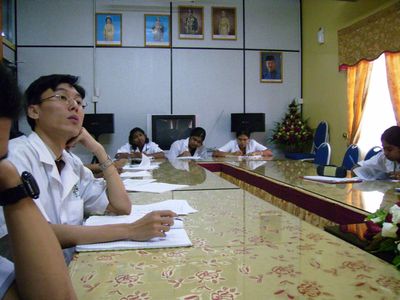
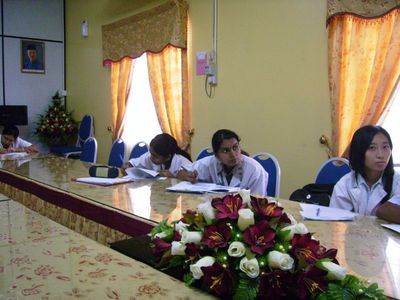
Left: Full attention from Students.
Right: "Enapa" Helly, are you looking at the cam? Concentrate k..?
We will only highlight the information in the context of our local settings during the discussion of Environmental Health. Firstly, Mr. Tn Hj. Samad introduce what is vector borne disease and explained that the vectors can be classified into Mosquitoes, Cockroach, Rodent, vetenerian and etc. The diseases monitored under this unit are Dengue, Japanese Encephalitis, Malaria, Filariasis, yellow fever, and Thypus. Specifically he told that if Aedes index is >= 5% (e.g. if 100 household is to be surveyed, 5 houses have Aedes larvae is considered to have Aedes index of 5%).
On the water quality control issue, we were informed that most of the Malaysian water supply is from surface water. The parameters follow by Malaysia is Malaysia Standard of Drinking Water.
According to him, our Malaysian Sandard of Drinking Water has higher level of standard than what is given in WHO standard as WHO set in such a way that it suites all country. We must be really thankful that Malaysian has fully treated clean water. We must take the suggestion like what Prof. Dr. Narayan said, "You don't have to boil the water for drinking" and by Adrian, "We boil water for making coffee or beverages only".
He also explain briefly on how water surveillance is done. Water are taken from river and channeled to treatment plant, to reservoir, and then distribute to household by reticulation technique (i.e. it is just like how carotid artery branches out to become external art., facial art., maxillary art., nasal art. and so on). The surveillance is done by taking water sample from each braching of the pipe line and this point is called sampling points. Normally, when there is an outbreak of water borne disease the pipeline proximal to the contaminated water is closed. Like wise if the pipe is broken or leaking, the proximal point of the leakage is closed for repair. He gave an example of cases happed in Perak whereby a foreigner transmitted Hepatitis A via water pipeline.
We asked a question to him in which most student always confused. It was the role of BAKAS and Water Quality Control Unit (WQC). He explained that the WQC is handled by private sector whereas BAKAS is by government. WQC produce the water taken from government,and then the processed water is sold back to the government to supply for the 'Rakyat'. In the other hand, BAKAS produce water in small scale. Why small scale?Why produce since the WQC is producing merely the total water supply to the Nation? Well, BAKAS initiate to find water source if there is no such services like those in rural area. They will find the source of water from underground. They will dig and fix a pipe connected to underground. Besides, BAKAS also incharge of setting Sanitary Latrine, Sulage Water, and "Lubang sampah" (Rubbish Hole).
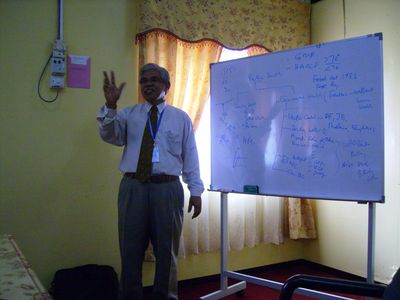
He taught us with full commitment.
We were also explained on Food Safety & Quality Control. The license is obtained from 2 authorities before a food is allowed to be sold locally or internationally. For local permit, Good Manufacturing Process (GMP) must be practiced before the license is granted. Under this rule, there must be a proper way of preparing food and proper way of handling it. In order to export food to international market, internationally trusted body or authority in Malaysia will be the Hazard Analysis Critical Control Point (HACCP). The law implemented in this unit is Food Act 1983 and Food Regulation 1985. During an outbreak of food poisoning, the problem they faced locally is that the food sample is not easy to obtain due to:
- 1. The particular causative food was totally sold off (delicious food are always unhealthy food)
- The chemical effect decrease with time, thus, the chemical count (in ppm) decrease up to the level the it can't be detected by the time of investigation.
- The side effect of the poisonous food emerge late
Under General Health he discussed briefly that Env. Health Unit will assess Housing Plan in which they will assess the future building will be overcrowded or not. Like wise, they will also assess premises.
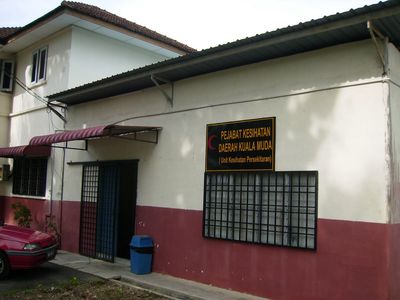
Environmental Health Unit.
After around 1 and half an hour seminar, we went to Infectious Disease Control Unit. We were briefed by Mr Zamani, Ass. Env Health Officer PPKP U29, on Notification and How the surveillance referral systems. Malaysia is following CDCIS (Communicable Diseases Control Information System) for notification. As we know, there are 2 types of notifications. One is within 24 hours, the other is within a week. For the 24 hour notification, a phone call must be made to CDC unit of the DHO. At the same time, notification form must be summited also. The call is made for fast preventive action by CDC unit of that particular DHO. Notification can be done by Private doctors or Hospital. The notification system started this year in Malaysia is E-Notice which is a web based notification system. The information can only be keyed-in only by CDC unit of the DHO or directly from Hospital. E-notice data collection is based on state only i.e. when all the total cases are sum up, it will be the total cases that reported in say Kedah state only but not from other state.
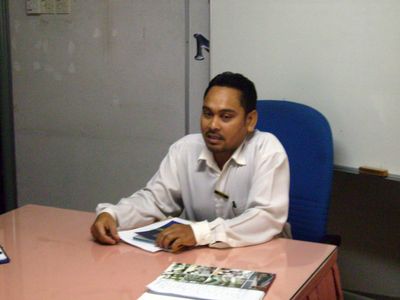
Mr Zamani, Ass. Env Health Officer PPKP U29
Out of so many diseases that must be notified, 4 cases in Malaysia can be notified based on symptoms and signs namely Food poisoning, HFMD, Tetanus and Measles. Meaning that, these 4 diseases are in confirm status, no laboratory investigation is required. After keying into e-notice, a separate notification of Measle cases are notified in SN2 (System Notifikasi 2). In SN2, confirmatory laboratory test is required. The problem face locally is that the doctor notify disease by filling inappropriate laboratory tests. (e.g. A measle is confirm by serology test but the doctor confirm it by Full Blood Count).
The highlight of the discussion is that , if a patient came from other state but is notified under KMDHO, how is the notification is to be done since the disease might occur from other place?
E.g. of the senario is:
If a patient who is from Melaka and got one of the notifiable disease from Melaka but he was diagnosed in Hospital Sultan Abdul Halim (HSAH) because he was studying in Kuala Muda District. HSAH will report to KMDHO. KMDHO then will report back to State Health Office SHO of Kedah. SHO of Kedah will register the case as Kedah case per se but will notify SHO of Melaka. The data collected will be transfered to SHO of Melaka later on and case will be deleted in SHO of Kedah. This is important in statistical studies in the sense that the data will not cross over to other states. Back to the flow now, when SHO of Melaka receive the notification, DHO of Melaka will be notified by SHO of Melaka. However, practically DHO of Kuala Muda will give a call to DHO of Melaka informally. Reason is the same, to take immediate action in prevention.
Second senario is that, if a person is from Yan district and was diagnosed in Kuala Muda district. How is the notification goes about in the same State? HSAH --> KMDHO --> Yan DHO. Here, no SHO of Kedah is involved.
Then we continued our day with another seminar which is given by Mr. Tan Siok Kong Senior Ass. Env. Health Officer (U32) on Investigation and Prosecution. There are 4 main acts practiced:
- Food Act 1983
- Food Regulation 1985
- Tobacco Control Regulation Act 2004
- Infectious Disease Act 1998
He gave example briefly for each act. In Food Act 2004, Benzoic acid must be less than 750 ppm only allowed food product such as Chilli sauce. For Infectious Disease Act, only some is practiced in real life such as Dengue case. This unit can't prosecute doctor who never initiate to notify the notifiable diseases. He explained to us more on Tobacco control act 2004. The stress the point that non-smoking area include worship place, government dept., shopping comlex, clinics, bus station, and air-cont. restaurant. Ministry of Health also minimised the number of cigarette in a pack to 20 sticks per pack only. MOH also enforced that no loose pack of cigarette can be sold as this will encourage adolescent buy it due to cheaper price. About how investigation and prosecution is done, we will discuss it in detail in next section under daily specific report. He explained what was told above via what he remembered because he couldn't find his power point. Thus, we were also tought about FORENSIC PHOTOGRAPHY.
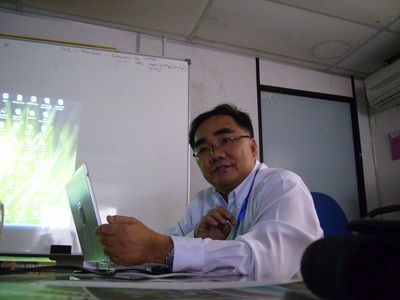
Mr. Tan Siok Kong Senior Ass. Env. Health Officer (U32)
The core concept of forensic photography is that a picture must be taken clearly with full details that can be use as exhibit for prosecution. It include overview picture of the place, focus part of the place, and zoom image of the evidence. It is like before you want to operate a patient for CABG, before you are able to see a patient's heart, you must first see the patient as a whole (Let's say we capture a picture of the whole body, Image 1). then we will focus on the chest area (image 2), then focus on incised sternum (image 3), then focus to the heart (image 4), then to the major coronary artery (image 5), then to the brach of blocked artery (image 6). In these 6 images, we must take a point for reference and the point can be object that is not moveable or changed. E.g in this case, we include the patient's face into each picture. The main idea of taking a point specific to the patient is that when any lawsuit is taken, the picture could not be falcified by using other patient's picture.
If not clear with what we said, we will give another senario. Let's say a mosquito larvae is seen in a pot located in a hotel. First image will be overview of the hotel. We take the hotel's name as point of reference in that pic. Then we focus the door and include the hotel's name taken in first image. 3rd image will be the focus picture of the door and this time take a pole in the hotel as reference point (say there is a big unumovable pole in that hotel). Then Image of the way leading to the toilet is taken WITH THE POLE STILL SEEN IN THAT PIC. Then the picture will lead us to the toilet with the pot visible located in the toilet. We again zoom the image pot the pot including the items that can be found surrounding the toilet. Then we take another picture of a sample taken from the pot. By this method the owner of the hotel could not deny that the pot containing mosquito larvae is not his!
After lunch break, we rushed back to the meeting room in order to meet Dr. Shawirajan at 1.30pm. He briefed us on what to do and what information to get from KMDHO. He was the Medical Officer of Health PKD (U52) of KMDHOonce before joining AIMST.
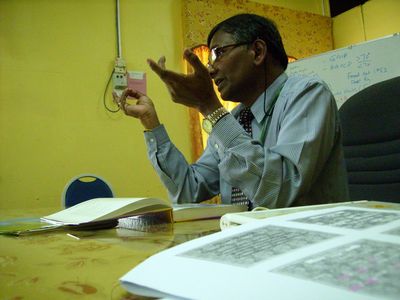
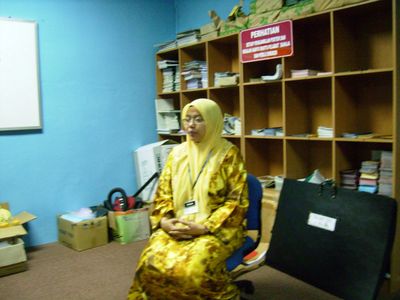
Left: He's the man! Our respected Dr. Shawirajan.
Right: Mdm. Norejan, Health Promotion Officer PP(PK) S41
Then from 2pm to 3pm we we briefed quickly by Mdm. Norejan, Health Promotion Officer PP(PK) S41 on the activities done and "Doktor Muda" program (YOUNG DOCTOR PROGRAM). We will not talk about this in detail because:
- We lack of time (3pm has got anti-smoking operation prepared especially for us by Investigation and prosecution unit)
- The verbal information was explain too fast and we could not digest it fuly.
- The person sitting before this computer is sleepy as the time now is 2.16am and yet specific report has to be "blogged".
Somehow we managed to ask meaning of the grade designation.
- U = Heath unit (e.g. U41)
- R = Driver (e.g. R1)
- S = Social (e.g. S41)
- N = Admin (e.g. N17)
- M = Management (e.g. Not identified yet
- W = Finance (W17)
For those with number 41 and above are degree holder and below 41 is diploma holder. For those with 17 and below can apply with SPM result.
Thanks for the patience by reading such a "long essay answers" and we hope the reader can benefit from these information. Thanks and see you in specific daily report and then the-person-before-the-computer can retire to bed.
28.7.08 (DAY 2) : OPERASI PPKHT 2004 (OPERATION TOBACCO CONTROL 2004)
MISSION :
OPERASI PPKHT 2004 (OPERATION TOBACCO CONTROL 2004)
OBJECTIVES:
1. TO CREATE AWARENESS AMONG SMOKER THAT THEY HAVE TO RESPECT THE NON-SMOKER IN PUBLIC PLACE.
2. TO GIVE COMPOUND TO THE OFFENDER IN PUBLIC PREMISES AS A WAY TO MAKE THEM AWARE.
LOCATION:
CENTRAL SQUARE, SUNGAI PETANI, KEDAH DARUL AMAN
DATE & TIME:
3PM - 6PM, 28 JULY 2008
TEAM:
TEAMS IN THAT OPERATION. THE TEAM CONSIST OF ASS. ENV. HEALTH OFFICERS, 8 TRAINEE ASS. ENV. HEALTH OFFICES, AND 13 KMDHO TEAM OF AIMST STUDENTS. EACH TEAM IN CHARGE 2 FLOORS (I.E. G&3, 4&5)
LAW USED:
PERATURAN-PERATURAN KAWALAN HASIL TEMBAKAU 2004(TOBACCO CONTROL ACT 2004)
TARGET:
THE SMOKER WITH HIS/HER CIGARETTE STILL BURNING WITHIN THE CONFINED AREA OF RESTRICTED SMOKING ZONE
EXHIBIT:
CIGARETTE OF THE OFFENDER
DESCRIPTION:
- Smoking operation is done twice in a month in premises where smoking is prohibited.
- Police force accompany the team to handle difficult case (uncooperative offender) and to search the pocket of offender (in a case whereby the offender refuse to give the cigarette).
- The cigarette is collected in a sealed bottle as exhibit for the prosecution
- A notice is given to offender during the operation.
- Offender is given 4 weeks time to pay the summon at Finance Dept. Of the KMDHO Administrative Department.
- Maximum of 2 weeks are required for DHO to get consent from Deputy Public Prosecutor (Alor Star)
- Meaning that, if consent is not gained from Public Prosecutor, offender can't pay the compound yet. Thus he/she has maximum of 2 weeks duration to pay (4weeks - 2 weeks)
- Each compound cost RM250/stick of cigarette.
- If the offender pay the compound, the case is closed.
- If the offender doesn't want to pay or never pay within 2 weeks, the case will be taken to civil court.
- Offender who wants to pay may appeal to less the amount of compound. The extent of reduction depends on the negotiation between 2 parties (Offender and PPKPK).
- The Maximum Charge by the court is RM 10 000 or 2 years jail or both.
METHODOLOGY:
- Offender is noticed and approached.
- The Ass. Env. Health Officer has to show the offender their ID or Badge and introduce themselves briefly.
- Offender is explained that there is a rule that smoker must not smoke in public premises (Peraturan 2/Regulation 2) of Non-smoking area.
- Offender is made clear that he/she has offended the law.
- Offender is asked to put his/her lighted cigarette into a clean new bottle so that the cigarette contain only his finger print and not contaminated or for DNA analysis if offender challenge the case.
- The bottle is sealed off around the cover of the bottle by a special template so that the exhibit will not be disturb or changed by any interested party.
- Offender is asked to show ID of his/hers
- The notice sheet is written with correct details of the offender. There are 3 sheets with 3 different colours. White is original copy, Yellow is for the offender, and Green is for Audit.
THE THUMBS OF THE PROCESS:
- The blogger of this page has tried to censored the details of the pictures shown below in order to protect the offender's rights an confidentiality.
- The blogger intend to put the pictures below for educational purposes only and will not be responsible for any malicious act by others who misuse the pictures below for any other purposes.
- If it is against the law, the blogger is cooperative to delete the pictures immediately when contacted.
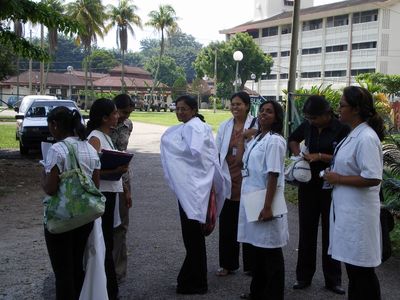
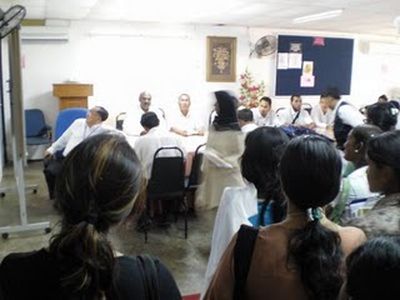
Left: KMDHO team of AIMST medical students get ready for action!
Right: Plans briefed in Operation Room.
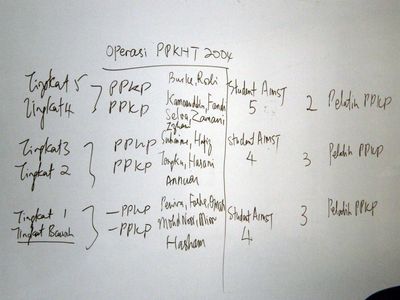
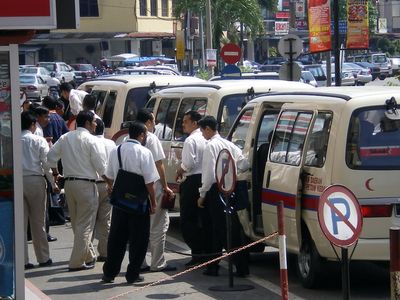
Left: AIMST Med. Students are honored to be part of the team!
Right: Arrival of the teams. ~LOCK AND LOAD!~
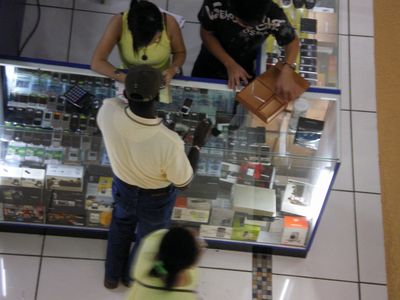
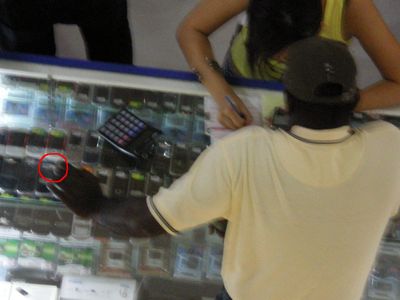
Left: Suspected offender spotted.
Right: Cigarette in his left hand.
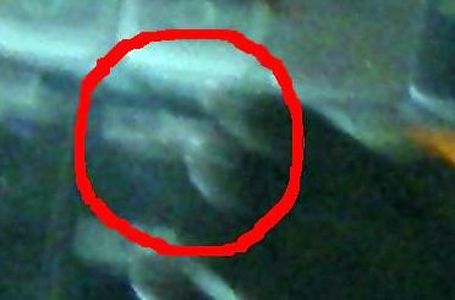
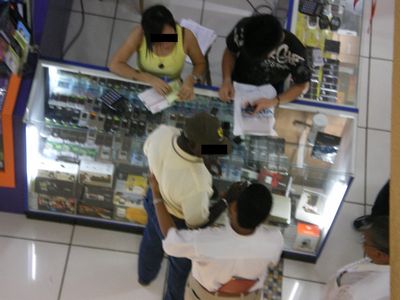
Left: Cigarette detected. Target confirmed!~
Right: Target approached, introduced, and explained.
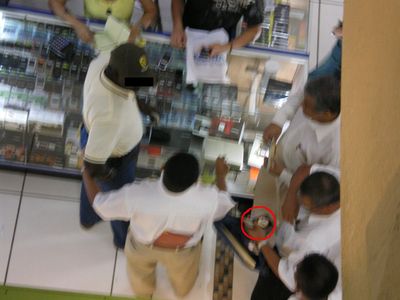
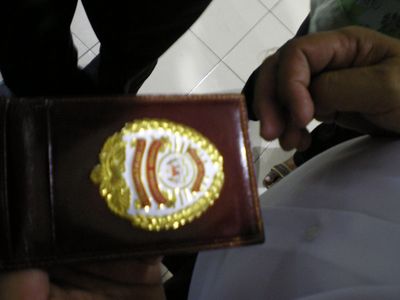
Left: The red circle is the badge of the Health Officer shown to the offender.
Right: The cool Badge~~~
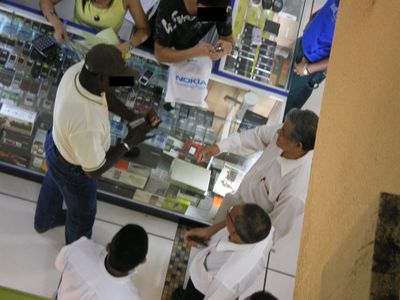
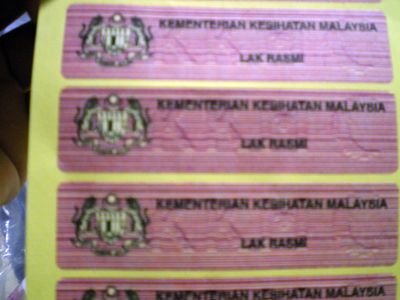
Left: Offender is asked to show his ID and notice is written.
Right: The seal...
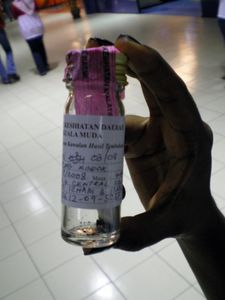
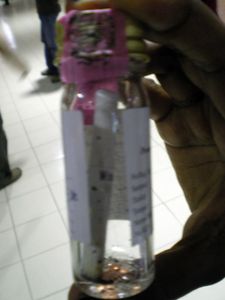
Left: Cigarette put into a bottle and sealed..
Right: Cigarette act as evidence.
29.7.08 (DAY 3) : Fogging
MISSION :
2nd Fogging due to positive Dengue case (done on 7th day after the 1st fogging)
OBJECTIVES:
- To control Dengue outbreak at that particular area
- To kill possible remaining adult mosquitoes carrying Dengue virus (1st fogging only killed adult infected mosquitoes but not the infected larvae)
- Enable student to learn the process of fogging like us
LOCATION:
Bandar Baru Housing area, Sungai Petani, Kedah (HOT SPOT OF DENGUE OUTBREAK)
DATE&TIME:
29 JULY 2008, 1730-1930 HOUR
TEAM:
Pekerja Rendah Am PRA U1, 13 AIMST Medical Students, Municipal Workers
LAW USED:
Destruction of Disease-Bearing Insect Act 1975 (DDBIA) and Prevention & Control of Infectious Disease
TARGET:
All of the unfortunate flying mosquitoes (since we can't specifically kill Aedes)
TOOLS USED:
- Thermal fogging machine (Please remember to fill either water-base or oil-base "mosquitocites")
- Goggle
- Head-set like sound proof device
- Mask
- Gloves
- Fogging Uniform
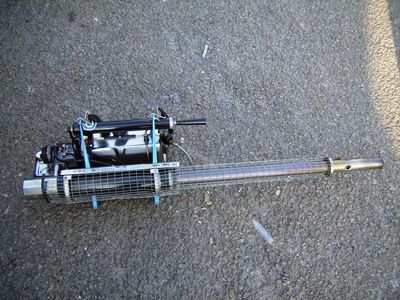
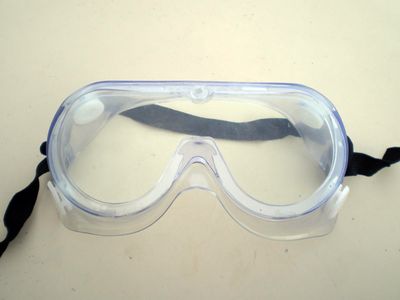
Left :Termal Fogging Machine (Looks like machine-gun to us)
Right :Goggle
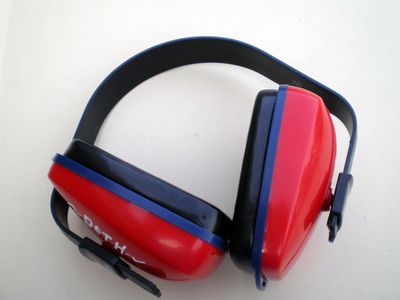
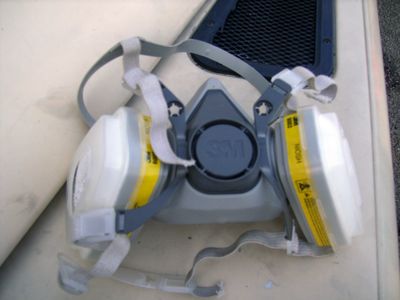
Left :Sound proof device
Right :Really cool Mask
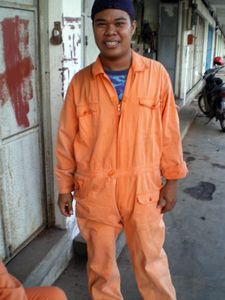
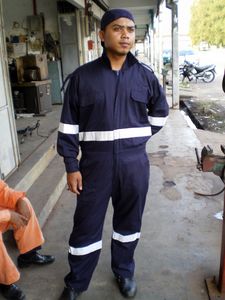
Left :Old Style Uniform (No one can see him at nitght)
Right :New look
DESCRIPTION:
- Fogging is normally done in the evening during sunsets for 3 reasons:
- Mosquitoes are like us, we don't like hot sun
- By evening, the sun sets and human heat easily sensed by their "infrared eyes"
- the active ingredient will evaporate like sweats into the air making it less effective in killing mosquitoes.
- Fogging will be done within 1-2 hours for 2 reasons: a) to prevent staff from tripping steps or falling into a drain due to fogging effect and pitch black night b) the resident could not start their dinner
- Fogging shall never be done in 3 situations: a) when there is funeral or marriage in that particular place b)when it is raining c) when there is a kenduri (Feast/party)
- Fogging is normally done from 6.30-7.30pm but also depends on the sunset mainly.
- If a person do not allow fogging to proceed in the house, a notice is given and if the person still ignore the notice, DDBIA 1975 can be used in lawsuit.
- There are 2 types of fogging methog namely Ultra Low Volume (ULV), whereby a car is used to spray the insecticide and thermal fogging machine which was shown above.
- ULV can only fog outside of the residency and a slow moving vehicle with 5-8km/hr speed is required.
- Thermal fogging machine can be used to fog outside and inside the house but require more apparatus.
- A radius of 200m must be "fogged" simultaneously (why so?it's because the mosquitoes can't fly beyond 200m radius thus they will have to die within 200, exception applied to mosquitoes with good stamina)
- The active substance used as insecticide is Permethrin.
- It can be prepared as water based (water + Permethrine) or oil based (20mL of Permethrine/1L of diesel).
- The fogging tank can fit around 5.5 L thus a total of 5L preparations can be prepared. Let's test you math! If 5L is to be prepared, how much liter(s) of Permethrin needed?
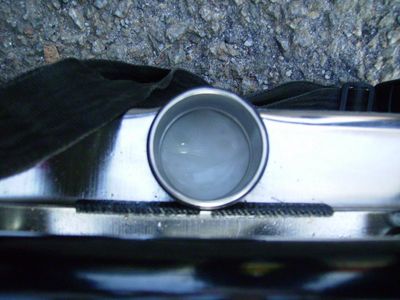
Water based perparation
METHOD:
- Notify the residents about the fogging so that they can take appropriate measures to cover their food and keep their clothes.
- Fog areas including drain, bushes, houses and surrounding area.
- Bath straight away after conducting such activities.
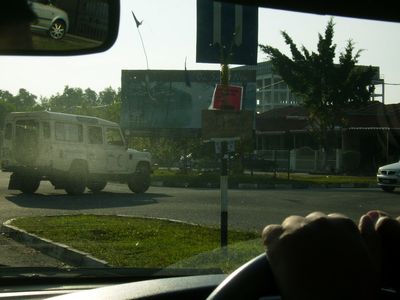
Reaching the "HOT SPOT"
When we reached the destination, the 13 of the AIMST medical students of Batch 7 went to notify the residents and guess what happened to the individual of them?
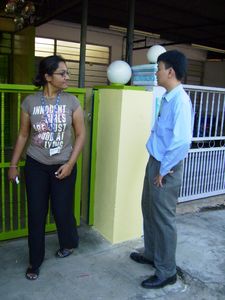
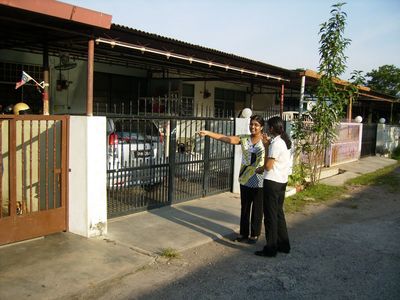
Left :THE RESIDENTS THOUGHT THAT WE WERE SALESMAN AND SALESGIRL
Right :DINESHI AND THANA WERE GREETED BY SOMETHING BEFORE THE GATE.
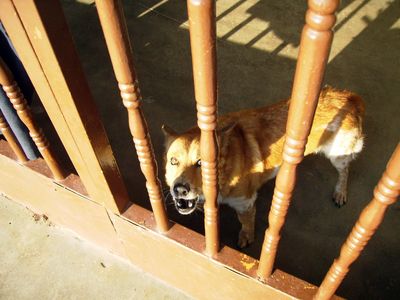
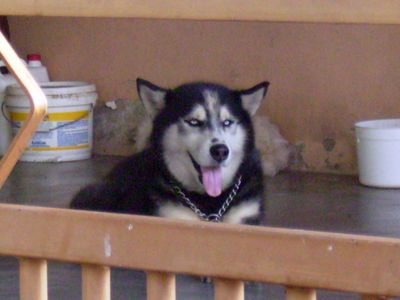
Left :A CUTE SHORTY DOG BARKING TO SAY DON'T FOG ME..
Right :YEA.... A TAME-LOOKING SIBERIAN HUSK! THANK GOD HE'S BEFORE THE GATE.
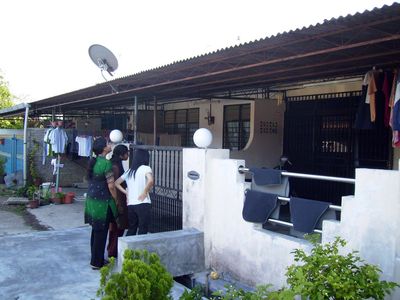
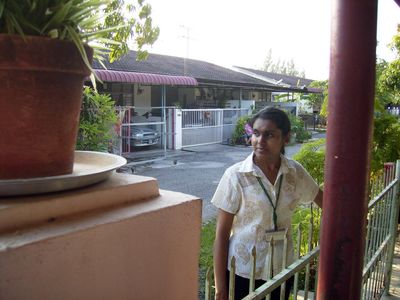
Left :RATHNA, HELLY, AND PARI CALLED THE OWNER BUT THEY WE'RE HIDING IN THE HOUSE NOT COMING OUT
Right :THANA FELT WIERD WHEN THE DOOR IS WIDELY OPEN BUT NO PEOPLE IN THE HOUSE AT THAT PARTICULAR TIME.
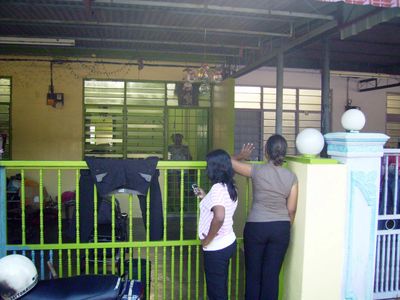
Left :KAVITHA AND PRAVENA GOT A GOOD RESIDENT WHO LISTENS TO THEM
After the notification to the residents, we waited the staffs to fog but they were sitting at corridoor as if they were waiting for someone. However we discovered our own activities while waiting for the so-called "someone".
We were contesting "who is holding the thermal fogging machine correctly". In you opinion, which of the following are the correct method of holding a "fogging machine"?
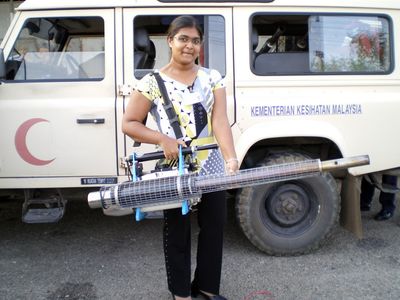
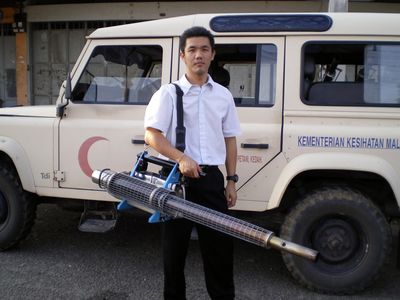
Left : Dineshi's 'salesgirl's' style?
Right : Yew Chai's 'soldier-of-fortune' style?
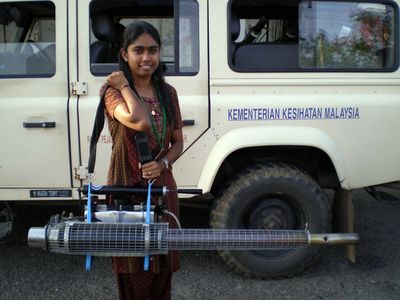
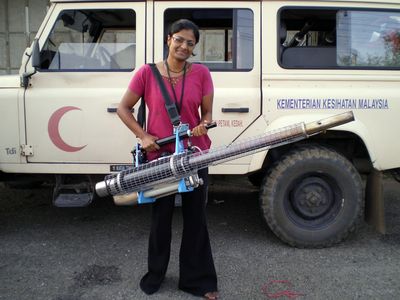
Left : Rathna's 'i-am-going-to-school' style?
Right : Shankri's 'Anopheles-resting-position' style?
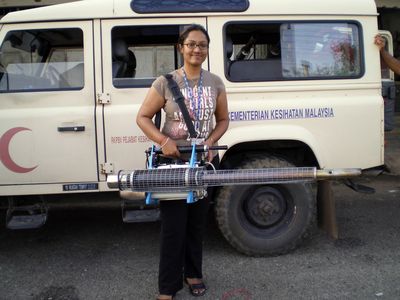
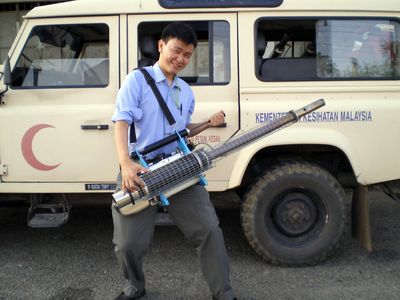
Left : Pravena's 'Aedes-resting-position' style?
Right : Gan's 'holding-a-guitar' style?
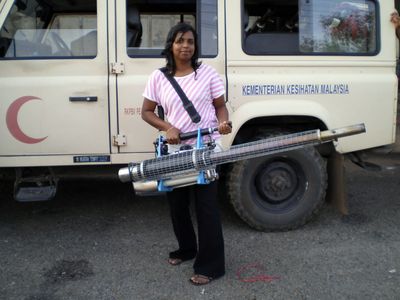
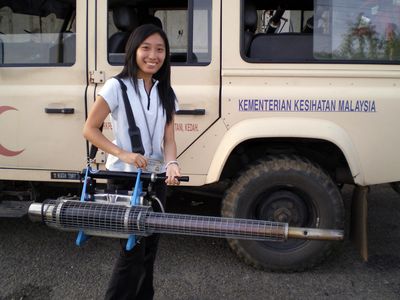
Left : Kavitha's 'Selamba' syle?
Right : Helly's 'stewardess' style?
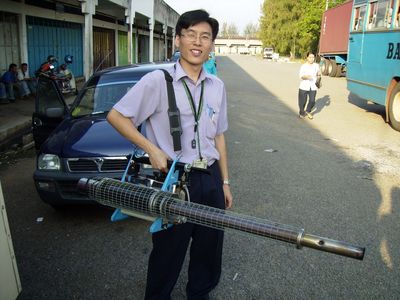
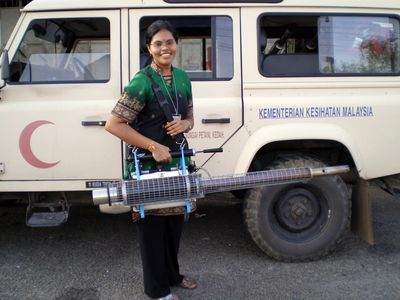
Left : Chia Leong's single-handed style?
Right : Pari's 'holding-a-handbag' style?
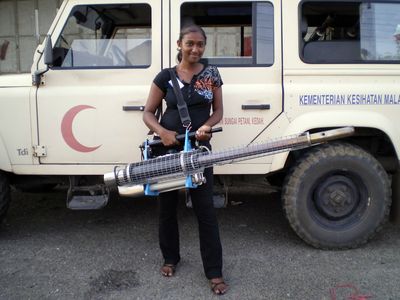
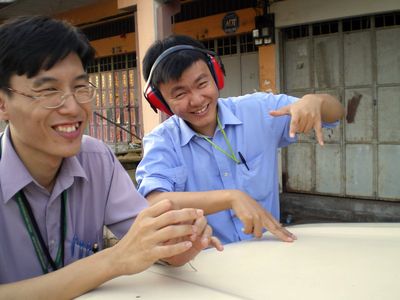
Left : Gaaitheri's 'Terkangkang' style?
Right : Ever wonder why the DJ's not deaf? Because they used sound-proof device in Disco
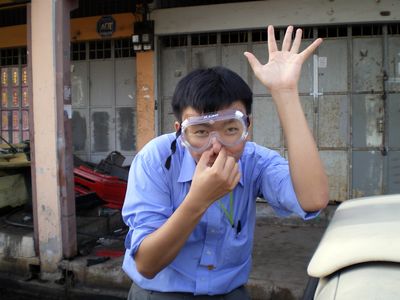
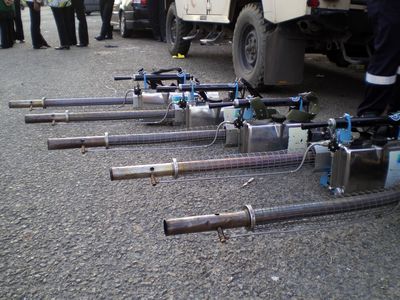
Left : The goggle is sealed so tight that it can also be used for swimming.
Right : After 20 minutes of waiting, we arranged the fogging machines on the floor and we stood around waiting what the staffs were waiting for.
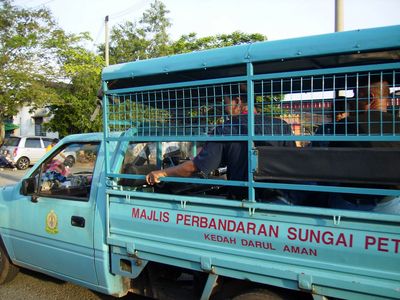
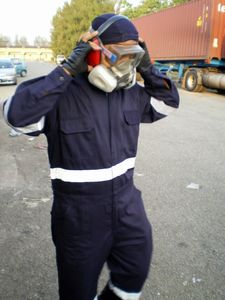
Left : Finally after 30 minutes of waiting we got to know what were the staff actually waiting for.
They were waiting the Municipal 'Fogger' Team
Right : He looks like a SWAT rather than a "fogger"
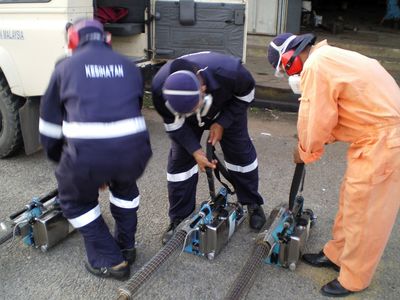
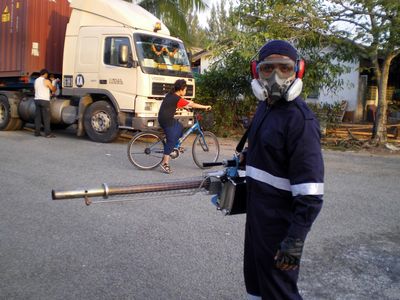
Left : They started that noisy buzzing sound of the fogging machine.
Maybe it is the loud buzzing sound that frightened those mosquitoes away rather than that Permethrine.
Right : LOCk & LOAD!!~~ (He actually waited 15s for me to snap him in that position)
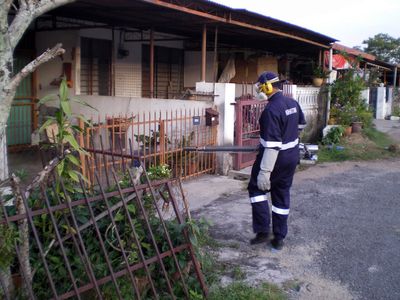
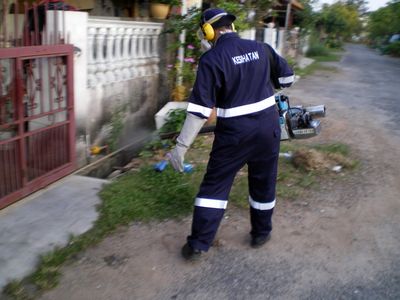
Left : ERm.. Mr. Fogger, where is the smoke?Is your machine working?
Right : Have you ever wonder why the smoke is not as white as you seen before?
That's because they used water based preparations.
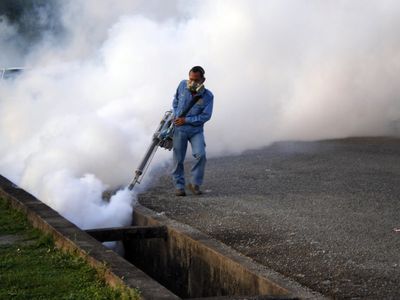
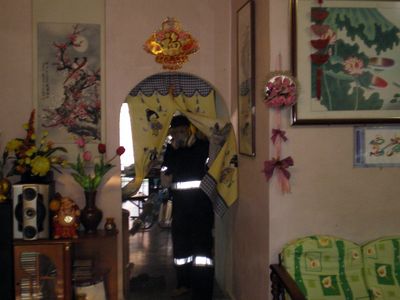
Left : This is what we call oil-based preparations
(hmn.. he's not wearing Gan's DJ head-set and not even a swimming goggle)
Right : Water-based fogging is suitable for inner house fogging.
Hope you guys and girls enjoy this session!
29.7.08 (DAY 3) : CDC: HIV, TB AND LEPROSY
We assembled at the Communicable Disease Control (CDC) Unit meeting room at 8am with Mr. Mohd Fendi Ibrahim, Ass. Env. Health Officer PPKP of CDC unit in charged of Tuberculosis and Leprosy.
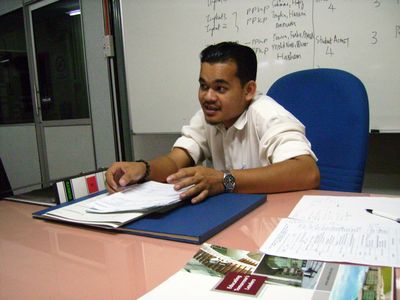
Mr. Fendi, Ass. Env. Health Officer PPKP of CDC unit
Mr. Fendi briefed us regarding the procedures undertaken to register patients diagnosed with TB and Leprosy. There are 120 patients diagnosed with TB in KMDHO. When a patient has been diagnosed with TB, the notification form together with several other forms such as that mentioned below are filled:
- TBIS 10A1: Regarding the details of commencement of treatment
- TBIS 10A4: To be filled by investigator and sent to Pusat Rawatan 1 regarding registration details.
- TBIS 10C1: Concerning the investigation carried out to confirm diagnosis
- TBIS 10A3: Regarding socioeconomic status, drug treatment, detail regarding conditions of the surrounding environment, and to identify risk factors.
These forms are filled up by the medical and health officer (M&HO) and sent to the DHO, where it is registered in a registration book for TB patients. Details regarding treatment, whether the patient is dead or alive is also entered in the registration book . If the patient is dead, it is important to mention if the patient passed on within 2 months of commencement of treatment or after (signify that the patient is in severe TB infection). The death of a TB patient should also be documented in Borang Siasatan Kematian Kes Tibi Dalam Rawatan. The case is then entered into the e-notifikasi database and separately MyTB database system.
Mesyuarat Audit Kematian Tinggi is held once in 6 months among doctors who treated TB patients and PPKP of TB & Leprosy unit to discuss the cases and certify deaths due to TB. If the patient diagnosed with TB is a foreigner, a letter is sent to the immigration department to facilitate the sending off of the patient to native country.
Defaulter who is present with TB symptoms 2 months after commencement of treatment will be registered as new case.
Then, we were told about the registration of Lepers.
There are only 2 cases of leprosy to date in KUALA MUDA district, one of them being a Nepalise who has been sent back to Nepal. The protocols to be followed in dealing with a leper is according to Manual Pengurusan Kusta. When a patient is diagnosed with leprosy, Borang Appendix 2A is filled up and submitted to KMDHO.
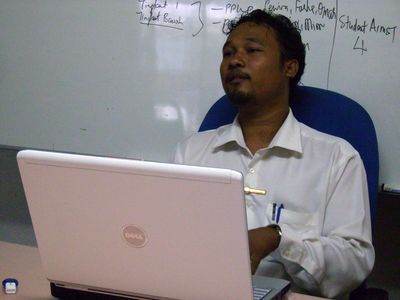
Mr. Hasani, PPKP of HIV/AIDS division
At 10am we were joined by Mr. Hasani, PPKP of HIV/AIDS division. he first explained the objectives of this division, which is to decrease the incidence of HIV patients in the community by health promotion, curt transmission of HIV infection and to prevent HIV infection among teenagers via PROSTAR (Program Sihat Tanpa AIDS untunk Remaja).
He continued to explain to us regarding the procedures undertaken to register a HIV/AIDS patient. Notification form is filled in by the doctor who diagnosed the patient with HIV infection or AIDS. The notification form is submitted to the DHO and registered by the PPKP in charge. Investigation will be carried out on all reported cases by the PPKP in charged. All persons who are in contact with the patient will be given retroviral therapy and counselling.
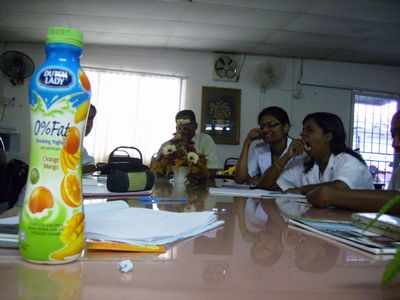
Kavitha, are you yawning? GOtCha~~~~!
Death of a HIV/AIDS patient will have to be documented and submitted to the Ministry of health. The HIV/AIDS division will have to send representative to the late patient's house to observe the rituals that are performed to the remains, are performed as required. This division conducts course annually to educate the community on how to manage the remains of a HIV/AIDS patient following death according to HIV/AIDS Standard Precaution. We dispersed for lunch at 11am.
We assembled at Unit Kawalan Penyakit Bawaan Vektor (Vector Control Unit) at 2.30pm. We were given a talk by Mr. Burke A/K Patrick Lummuria regarding the notification and investigations of a dengue case. Once the Notification form of a dengue case is submitted to the DHO, a Health Inspector from the Klinik Kesihatan will be dispersed to investigate the case. The Health inspector will be required to fill up an investigation form for dengue case which will encompass details concerning the patiend and his/her surrounding environment. The inspector will be required to elicit details about the patient's activities for 14 days prior to the notification , as the incubation period for the virus before signs and symptoms manifest is 14 days. The details collected are also registered in Record Book and Vekpro (a database that is used but it is not online database system like e-notifikasi)
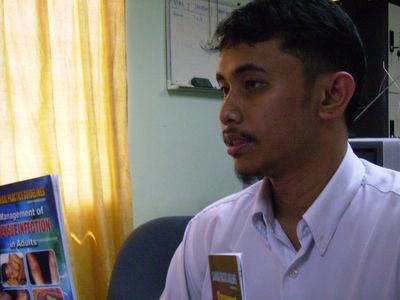
Mr. Burke A/K Patrick Lummuria PPKP of Vector (Control Unit)
24 hours following the notification, activities such as investigate the hospitalised patient,fogging, larvaciding and 'search and destroy' are performed within 24 hours following the notification. Aedes Survey is conducted within 48 hours of notification, whereby this unit will dispatch it's members to survey houses in the vicinity of the patient's house for larvae in bredding places such as stagnant water. The results of this survey will be converted into Aedes Index (BRETEAU INDEX) which is the number of house with positive larvae divided with number of houses surveyed times 100. If the index is more than 1 % control measures should be taken. The Aedes Index limit varied according to time.
When larvae is identified, the owner of the followint house or premises will be issued compund as follows:
- House = RM100
- Shop = RM150
- School = RM150
- Factory = RM500
The container consist of the larvae will be preserved with 70% + hot water. It will be used for investigation for the type of mosquitoe and act as exhibit if lawsuit should be approached.
At 5.30pm till 7.30pm, we followed members of this team for fogging activity at Pekan Baru housing area. we arrived at teh housing area around 6pm. we individually went and notified occupants of teh houses that the fogging activity will comnece at 7pm and approprate measures should be taken to prevent contamination of the food during the fogging activity. The fogging activity began at 7pm and we called it a day at 7.30pm after snapping pictures and observed the activities.
31.7.08 (DAY 4): KMDHO TEAM STARTED WITH HOPE BUT ENDED WITH DISAPPOINTMENT
As the title went, we really got disappointed when practical session for premise inspection and food sampling was cancelled as the person in charged could not make it to prepare us such activities. Besides that, it was Thursday and no food sampling will be taken as the Laboratory is off from friday till Sunday.
So, we continued with THEORY LECTURES again. We were briefed by PPKP Adam who is in charged of the Food Safety and Quality Control (FSQC).
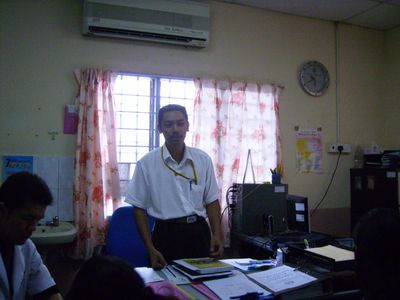
PPKP Adam
The law used by this unit will be the Akta Makanan 1983 ( Food Act 1983), Peraturan makanan 1985 ( Food Regulations 1985), and Standard Peraturan Air Minuman berbungkus 1985 (Standard Regulation of Packed Water 1985). Practically, Peraturan-peraturan Hasil Tembakau 2004 (Tobacco Control Act 2004) comes under the Food Act and Food regulation.
He told us briefly about what the factory has to deal with DHO before setting up a food processing factory and surveillance done in school/food premise, factory, restaurant and static stalls.
When a new food related factory is established, the factory is required to apply license from State municipal. The municipal will then forward a letter to FSQC of KMDHO. FSQC unit will then conduct a food sampling on that premise besides assessing the cleanliness of the factory, machine, tools, and the staffs. Typhi IV card of the employees are assessed as well. Thyphi IV card is an identification card that is given when salmonella typhi vaccination is given to the food handler of the factory or food premise.
Then a random sampling of the food product will be done. The sample will be sent to Jabatan Kimia Penang (Penang Laboratory Dept.) and check the parameters such as chemical, physical and microbiological. Sample that require chemical and physical assessment must be sent to Laboratory by 3 days whereas sample must be sent within 24hours for microbiological parameters. Microbiological parameters include checking the presence of Salmonella spp, Staphylococcus Aureus, E. Coli, Coliform count and plate count.
After that, the label of the product will be assess according to Food regulation Act 1985 under Regulation 18 in which label with "Super, 100% Natural, King, Class 1, Brilliant, Quality Guaranteed, and High Quality are prohibited". Well, if someone were to ask me "How bout the brand Super Ring, Beras Super, and King ice cream?". I can only say, " sorry, I have no comment ladies and gentlemen".
When every assessment is passed, Health certificate will be issued by DHO of the state to the factory and the factory can now export to overseas as long as the requirements are met with the standard set by the importing country. For a better recognition, factory can apply Good Manufacturing Practice (GMP) and/or Hazard Analysis and Critical Control Point (HACCP). GMP is well recognised locally but not internationally. For HACCP, it is recognised both locally and internationally. If factory has HACCP recognition, food sampling is exempted. The municipal will then issue certificate to allow manufacturing in the last step of application process. For further information, JAKIM (the body that certify HALAL'ship') has no connection with DHO and they assess the food by themselves.
If the food sampling does not meet the requirement, the factory will not be closed but instead, the batch of the food produced will be disposed and a new batch of food is produced. Then the new sample is taken again until the batch of food produced meets the requirement.
For imported food such as the food brought in from Thailand, the product will be held at least 1-2 weeks for sampling. All the parameters are checked before the product are permitted to enter Malaysia. This topic is covered very briefly as we do not really have the facilities to appreciate the process. Hope the DHO team that is posted near to Thailand border will give us more coverage on this topic.
As for food surveillance, it will be done twice a year (especially in school canteen). If there is 1 outbreak of food poisoning, the surveillance will be done once every 4 months (3 times in a year). The premises are classified into Factory, Restaurant/Food Premise, School Canteen, Static Hawker, and Seasonal hawker (e.g. Lontong, festive cakes,and foods sold at a particular festive season). The process of surveillance and food sampling will be discussed in specific topic of day 4.
Then our activity is continued with lecture from KPAS unit at 2.30pm to 4.30pm by PPKP Tengku Baharudin. According to him, this unit is temporarily focusing on the health staffs only and will expand their scope on the other fields later in future. The main aspect that is taken cared by this unit is the Sharp Object Injury, Hepatitis B vaccination program, and Healthy Setting Program.
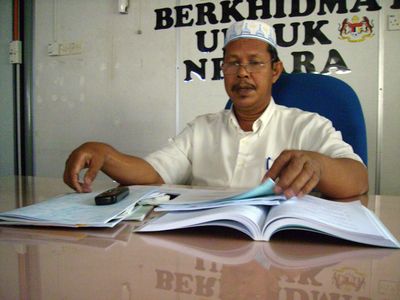
PPKP Tengku Baharudin
The law used in this unit will be Occupational Safety Health Act 1994 (OSHA ACT 1994). If someone is acting against this law, the guilty will be punished with a penalty of equal/less than RM50 000 or equal/less than 5 years of jail or both.
Any sharp injury must be notified within 24 hours to DHO office by phone and sent a notification form withing 7 days.
Healthy setting is then introduced to us. The definition of healthy setting is a place where everyone work together to achieve an agreed vision for the health and well being of worker and surrounding community. This program takes care of staff psychologically, socially and physically. A routine feedback is taken from staff on safe setting. This is to ensure health promotion and prevention are integrated into working environment.
This is all for today. Thanks for reading.
31.7.08 (DAY 4): SAMPLING OF FOOD FOR CHEMICAL AND PHYSICAL ANALYSIS
Early preparation starts in DHO on the matter of which premise to check; number, type of sample and type of food to be taken; tools for sampling; and who will be the witness (normally will be one of the staffs). Identification card and money must be prepared for the food (The sample of the food is bought for investigation and it is not 'donated' by the premise).
When we reach at that particular premise, introduction is given and identification card is shown. Then explain about the motive of the visiting.
Then randomly choose the food for sampling and payment is made. For retailer, a receipt is asked. If the sample is taken from a factory or import agent, no payment is made but a letter stating that DHO has taken the particular sample. Each time of sampling, 3 samples are taken randomly (but the same batch of food product). The samples are labelled. 1 sample is for the owner to keep, 1 is for analysis and the other 1 is for keeping in DHO store. This is important in the sense that when the analysed sample failed to meet the standard requirement (parameters), the same will goes to the other 2 samples. In this way, the owner will not be able to accuse DHO of making false or biased analysis. Then sample is then registered in HMIS and sent to Laboratory within 3 days.Once the food is proved to meet the criteria, the 3 samples can be disposed properly.
For microbiological analysis, the steps are the same as above. The only difference is that the sample required is just 1 in number. No sample is given to the owner or to be stored in DHO for reference.

